
Nordic Walking: Delve into the Techniques and Benefits of Nordic Walking
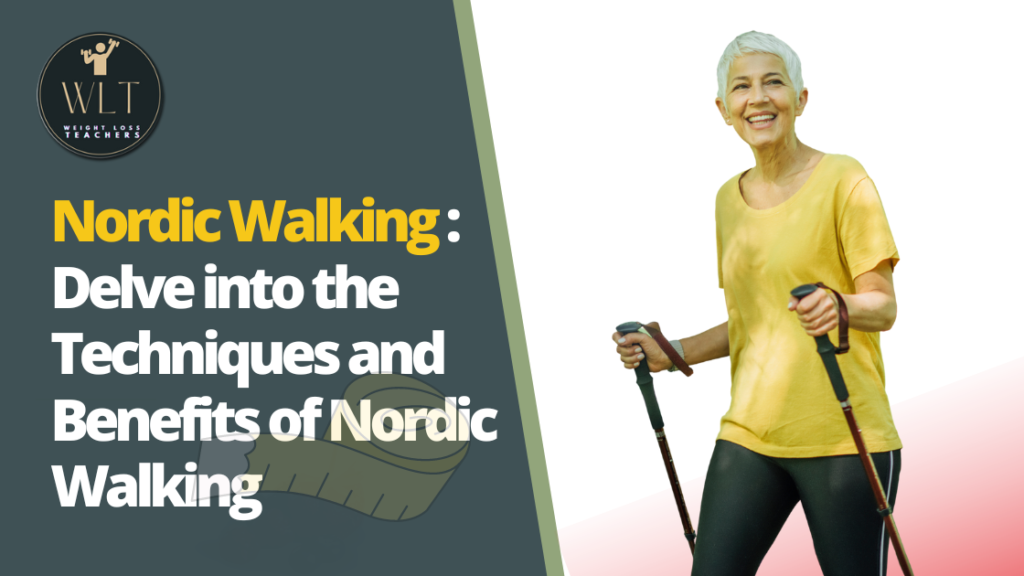
Nordic walking, a popular fitness activity that originated in Finland, has gained tremendous popularity worldwide due to its numerous health benefits and accessible nature.
Table of Contents
Combining walking with the use of specialized poles, this form of exercise engages the upper body, providing a full-body workout.
Nordic Walking
In this comprehensive article, we will delve into the techniques and benefits of Nordic walking, exploring its history, equipment, proper form, and the positive impact it has on physical and mental well-being.
- History and Origin of Nordic Walking
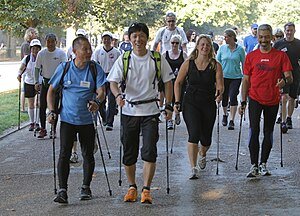
Nordic walking traces its roots back to Finland in the 1930s when cross-country skiers began using poles during the summer to maintain their fitness levels. This practice gained attention in the 1990s when it was developed into a formal exercise routine by Marko Kantaneva and Mauri Repo. Initially known as “Sauvakävely,” it quickly gained popularity across Europe and subsequently spread worldwide. Today, Nordic walking is recognized as a versatile form of exercise that caters to people of all ages and fitness levels.
- Understanding Nordic Walking Poles and Equipment

Nordic walking poles differ from regular walking or trekking poles due to their design and functionality. They are lightweight, adjustable, and feature specially designed rubber tips for various terrains. The poles play a crucial role in Nordic walking, providing stability, balance, and rhythm while engaging the upper body. It is essential to choose poles that are the correct height and made from durable materials to ensure proper technique and maximum benefits from the exercise.
- Technique and Proper Form
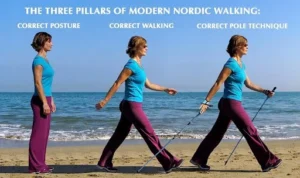
- Pole Placement and Gripping Techniques: Proper pole placement and gripping techniques are vital for Nordic walking. The poles should be planted diagonally behind the body, with the arm extended, and the pole angled backward. Gripping the handles correctly, using the strap for support, and maintaining a relaxed grip are essential for optimal technique and efficiency during the exercise.
- Footwork and Stride Length: Maintaining a natural stride length and walking at a comfortable pace is the key to Nordic walking. The heel-to-toe rolling motion ensures proper footwork, with the poles assisting in propelling the body forward. It is important to maintain an upright posture and engage the core muscles to enhance balance and stability.
- Upper Body Engagement and Swing: Nordic walking is characterized by the active involvement of the upper body. The swinging motion of the arms, synchronized with the stride, creates a rhythmic and balanced movement. The poles provide resistance and engage the muscles in the arms, shoulders, chest, and back, resulting in a full-body workout.
- Breathing Techniques: Proper breathing techniques enhance the effectiveness of Nordic walking. Breathing deeply and rhythmically through the nose, inhaling during the pole plant and exhaling during the arm swing, helps oxygenate the body, reduce tension, and improve endurance.
- Benefits of Nordic Walking

- Full-Body Workout and Increased Caloric Expenditure: Nordic walking engages over 90% of the body’s muscles, including the legs, glutes, core, and upper body. This results in a higher caloric expenditure compared to regular walking, making it an excellent option for weight management and overall fitness.
- Cardiovascular Health and Endurance: The rhythmic nature of Nordic walking elevates the heart rate, increasing cardiovascular fitness and endurance. Regular Nordic walking sessions can help lower blood pressure, improve blood circulation, and reduce the risk of heart disease.
- Low-Impact Exercise and Joint Health: Nordic walking is a low-impact exercise that puts minimal stress on the joints. The use of poles helps distribute the body weight and reduce the impact on the knees, hips, and ankles, making it a suitable exercise for individuals with joint issues or those recovering from injuries.
- Improved Posture, Balance, and Coordination: Nordic walking promotes proper posture by engaging the core muscles and aligning the spine. The use of poles helps maintain balance and stability, reducing the risk of falls. The coordinated movement of the arms and legs improves overall coordination and motor skills.
- Strengthens Upper Body Muscles: Unlike regular walking, Nordic walking incorporates the use of poles, which engages the muscles in the upper body, including the arms, shoulders, chest, and back. This results in increased strength and toning of these muscle groups, leading to a more balanced and sculpted physique.
- Weight Management and Increased Metabolism: Nordic walking, being a full-body workout helps burn calories and boosts metabolism. Regular sessions of Nordic walking combined with a balanced diet can aid in weight management, promote fat loss, and improve overall body composition.
- Stress Reduction and Mental Well-being: Engaging in outdoor activities like Nordic walking has been shown to reduce stress levels and improve mental well-being. The combination of physical exercise, fresh air, and the rhythmic movement can help alleviate symptoms of anxiety and depression, enhance mood, and promote relaxation.
- Nordic Walking for Different Age Groups and Fitness Levels
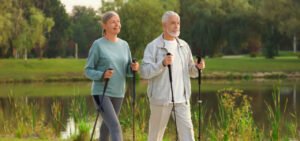
- Nordic Walking for Seniors: Nordic walking is particularly beneficial for seniors as it provides a low-impact exercise option that improves cardiovascular fitness, strengthens muscles, and enhances balance and coordination. It can help maintain bone density, reduce the risk of osteoporosis, and promote overall mobility and independence.
- Nordic Walking for Weight Loss: For individuals aiming for weight loss, Nordic walking offers an effective calorie-burning exercise. By incorporating the upper body and engaging multiple muscle groups, it increases energy expenditure and promotes fat loss. Combined with a healthy diet, Nordic walking can aid in achieving weight loss goals.
- Nordic Walking for Rehabilitation: Due to its low-impact nature, Nordic walking is often recommended as a rehabilitation exercise. It helps rebuild strength, flexibility, and coordination after an injury or surgery. The use of poles provides additional support and stability, allowing individuals to gradually regain their mobility and confidence.
- Nordic Walking for Athletes and Fitness Enthusiasts: Even for athletes and fitness enthusiasts, Nordic walking can be a valuable addition to their training regimen. It serves as an active recovery activity, providing a low-impact cardiovascular workout while giving the joints a break from high-impact exercises. Nordic walking can also help improve overall endurance, core strength, and muscle balance.
- Nordic Walking Events and Community
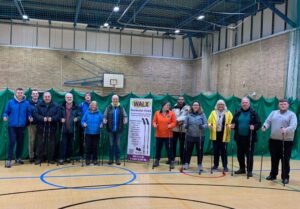
- Nordic Walking Competitions and Races: As Nordic walking gained popularity, various competitions and races specifically dedicated to this sport emerged. These events provide opportunities for enthusiasts to showcase their skills, compete with others, and celebrate their passion for Nordic walking.
- Group Nordic Walking and Social Benefits: Nordic walking is often practiced in groups, allowing participants to enjoy the exercise together and socialize. Group walks create a sense of community, motivation, and support. It provides an avenue to connect with like-minded individuals, make new friends, and foster a sense of belonging.
- Tips for Starting Nordic Walking

- Choosing the Right Equipment: When starting Nordic walking, it is important to invest in the right equipment. Select poles that are suitable for your height and made of durable materials. Comfortable walking shoes and weather-appropriate clothing are also essential for a pleasant experience.
- Finding Suitable Terrain: Nordic walking can be done on various terrains, including pavement, trails, or even beaches. Start with flat or gently sloping surfaces to familiarize yourself with the technique. As you progress, you can gradually incorporate more challenging terrains to further enhance your workout.
- Warm-Up and Cool-Down Exercises: Before starting your Nordic walking session, it is crucial to perform warm-up exercises to prepare your body for the activity. This can include dynamic stretches, light cardio exercises, and mobility drills. After your walk, cool-down exercises, such as static stretches, help prevent muscle soreness and promote flexibility.
- Gradually Increasing Intensity: If you’re new to Nordic walking, it’s important to start slowly and gradually increase the intensity and duration of your walks. Listen to your body and allow yourself time to adapt to the new exercise. As your fitness level improves, you can incorporate interval training or hill climbs to challenge yourself further.
- Seeking Professional Guidance: To ensure proper technique and maximize the benefits of Nordic walking, consider seeking guidance from a certified Nordic walking instructor. They can provide personalized instruction, correct any form errors, and design a suitable training plan based on your fitness goals and abilities.
- Frequently Asked Questions
In this section, we will address some frequently asked questions related to Nordic walking to provide further clarity and insight into this popular fitness activity.
Q1: Is Nordic walking effective for weight loss?
A: Yes, Nordic walking can be an effective exercise for weight loss. By engaging the upper body and increasing the intensity compared to regular walking, Nordic walking can help burn more calories and promote fat loss. Combined with a balanced diet, it can contribute to achieving weight loss goals.
Q2: How long and how often should I do Nordic walking?
A: The duration and frequency of Nordic walking sessions can vary depending on your fitness level and goals. For beginners, starting with 20-30 minute sessions, 2-3 times per week is a good starting point. As you progress, gradually increase the duration to 45 minutes or more. Aim for at least 3-4 sessions per week to maintain consistency and maximize the benefits.
Q3: Is Nordic walking suitable for all age groups?
A: Yes, Nordic walking is a suitable exercise for people of all age groups. It can be adjusted to individual fitness levels and requirements. From children to seniors, Nordic walking offers a low-impact option that improves cardiovascular fitness, strengthens muscles, and enhances balance and coordination.
Q4: What is the difference between Nordic walking and regular walking?
A: Nordic walking differs from regular walking in that it incorporates the use of poles, engaging the upper body and providing a full-body workout. The poles help distribute the workload, increase calorie expenditure, and enhance the overall intensity of the exercise. Nordic walking also offers additional benefits such as improved posture, balance, and coordination compared to regular walking.
Q5: Can Nordic walking be practiced indoors?
A: While Nordic walking is typically practiced outdoors to take advantage of natural surroundings, it is possible to practice it indoors using a treadmill or other suitable equipment. However, the benefits of being in nature, fresh air, and varied terrain are additional advantages that are best experienced outdoors.
Q6: Can Nordic walking be done by individuals with joint issues?
A: Yes, Nordic walking is a low-impact exercise that puts minimal stress on the joints. The use of poles helps distribute the body weight and reduce the impact on the knees, hips, and ankles. This makes Nordic walking a suitable exercise for individuals with joint issues or those recovering from injuries.
Conclusion
Nordic walking is a versatile and accessible exercise that offers numerous benefits for people of all ages and fitness levels. Whether you’re looking for a full-body workout, a low-impact exercise option, or a way to improve your cardiovascular fitness and mental well-being, Nordic walking can be a fantastic choice. By understanding the history, techniques, and benefits of Nordic walking, you can embark on this invigorating journey and enjoy a healthier and more active lifestyle.
Disclaimer: The information provided in this article is for educational purposes only and should not be considered as a substitute for medical advice. Consult a healthcare professional before implementing any home remedies or making significant changes to your lifestyle.






